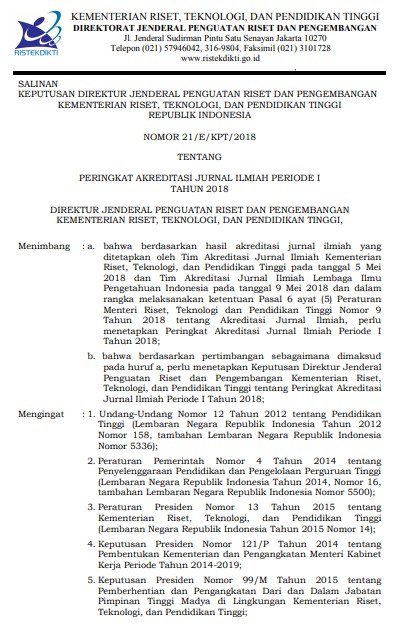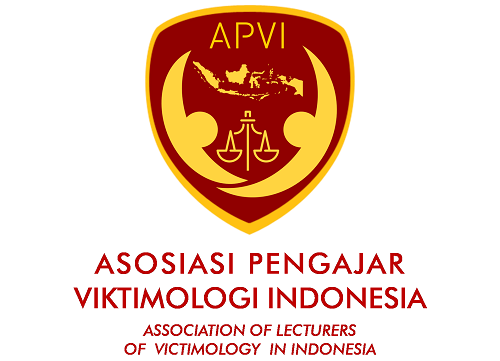Effectiveness of Mental Development of Prisoners in Cirebon Narcotics Prison Class IIA as a Form of Correctional Purposes
Abstract
The number of Narcotics-abuse continues to increase, for example needles and the making of tattoos, narcotics dependence not only causes a physical but also psychological impact on a person. The problem of this research was about the mental formation of prisoners and the model of their formation in the Cirebon Narcotics Prison. This research was an empirical study and the data collection included survey, observation, interview and literature studies. The data were qualitatively analyzed by descriptive method. The research findings indicated that mental coaching required operational guidance including, methadone programs, community therapy, coaching involving the community and Criminon Indonesia training programs. The mental development of Narcotics Prisoners has not fully implemented methadone and community therapy program; Criminon training has been fulfilled while the other has not. Guidance for prisoners must be integrated among the prison staff, the community and prisoners as well.
Keywords: Prisoners, Prisons, Mental Development
Full Text:
PDF View
References
Amiruddin. (2004). Pengantar Metodelogi Penelitian Hukum. Jakarta: Raja Grafika Persada.
Amri, SR. (2018). Efektivitas Pembinaan dan Fungsi Pemasyarakatan Pecandu Narkoba. Jurnal Jurisprudentie. 5(2). 199–218.
Anggraeni, KT. (2017). Kualitas Hidup Klien Terapi Metadon di Program Terapi Rumatan Metadon (PTRM) Sandat RSUP Sanglah. Jurnal Medika. 6(9). 29–33.
Astuti, A. (2011). Pembinaan Mental Narapida di Lembaga Pemasyarakatan Wiragunan Yogyakarta. Jurnal Citizenship. 1(1). 1-15.
Aulia, P. (2017). Terapi Kelompok Untuk Mengurangi Stres Anak Didik Pemasyarakatan yang Akan Bebas. Jurnal RAP UNP. 8(1). 69-78.
Bangsing, IK., & Wadhanti, A. (2017). Perencanaan dan Perancangan Lembaga Pemasyarakatan Dengan Penurunan Tingkat Depresi untuk Narapidana Perempuan. Jurnal Anala. 1(17). 1-8.
Belinda, RM. (2001). Commnity Based Corrections. Monterey California: Brooks/Cole Publishing Company.
Brabender, VA., Fallon, AE., & Smolar, AI. (2004). Essential of Group Therapy. New Jersey: Jhon Willey & sons, Inc.
Cohen, S., Kammarck, T., & Mermelstein, R. (1983). A Global Measure of Precived Stress. Jurnal of Health and Social Behavior. 2(4). 385-396.
Gani, S. (2013). Therapeutic Community (TC) pada Residen Penyalahguna Narkoba di Panti Sosial Marsudiputra Dharmapala Inderalaya Sumatera Selatan. Jurnal Konseling dan Pendidikan. 1(1). 54-57.
Gunarto, MP. (2009). Sikap Memidana yang Berorientasi Pada Tujuan Pemidanaan. Jurnal Mimbar Hukum. 21(1). 93-107.
Hairina, Y. & Komalasari. (2017). Kondisi Psikologis Narapidana Narkotika di Lapas Narkotika Klas II Karang Litan Martapuna. Studia Jusania. 5(1). 94-104.
Hamja. (2015). Model Pembinaan Narapidana Berbasis Masyarakat (Community Based Corrections) Dalam Sistem Peradilan Pidana. Jurnal Mimbar Hukum. 27(3). 446-458.
Hanson, GR. (2002). What is Therapeutic Community. Jurnal of Therapeutic Community. 2(3). 1-12.
Haryono. (2017). Kebijakan Perlakuan Khusus Terhadap Narapidana Risiko Tinggi di Lembaga Pemasyarakatan. Jurnal JIKH. 11(3). 231-247.
Hawi, A. (2018). Remaja Pecandu Narkoba : Studi tentang Rehabilitasi Integratif di Panti Rehabilitasi Narkoba Pondok Pesantren Ar – Rahman Palembang. Jurnal Tadrib. 4(1). 99-119.
Hubbard, LR. (2004). Criminon Indonesia. Los Angeles: Association for Better Living and Education International.
Imron, MA. (2013). Hubungan Fungsional Badan Narkotika Nasional dengan Lapas dalam Penanggulangan Narkotika di Lapas. Jurnal Ius. 1(2). 327-345.
Kottler, J., & Brown, R. (1996). Introduction Back to Herapeutic Conseling. Three Lakes: Cole Publishing Company.
Kristianingsih, S. A. (2009). Penahanan Pemenjaraan pada Narapidana Narkoba di Rumah Tahanan Salatiga. Jurnal Humanitas. 6(1). 1-15.
Law Number 12 of 1995 concerning Correctional State Gazette of the Republic of Indonesia in 1995 Number 7, Additional State Gazette of the Republic of Indonesia Number 3614.
Liwarti. (2013). Hubungan Antara Pengalaman Spiritual dengan Psikologikal Well-Being Pada Penghuni Lapas. Jurnal Sains dan Praktik Psikologi. 1(1). 1-12.
Mostafazadeh, B., Ebrahimi, R., Titidej V., Sanaeizadeh, H. (2017). Frequency of Pathological Changes in Lungs of Bodies with Positive Postmortem Toxicology Result for Narcotics and Psychotropic Substances. Iranian Journal of Toxicology. 11(1). 49-54. doi: 10.29252/arakmu.11.1.49.
Mujiati, M., & Budiartati. (2017). Kegiatan Pembinaan Rohani dalam Upaya Mengubah Perilaku Sosial Peserta Rehabilitasi Narkoba. Journal of Nonformal Education and Community Empowerment. 1(2). 146-151.
Narindrani, F. (2017). Sistem Hukum Pencegahan Peredaran Narkotika di Lembaga Pemasyarakatan (Studi Kasus di Lembaga Pemasyarakatan Cipinang). Jurnal Rechtsvinding. 6(1). 111-123.
Nastami, B. (2012). Kerentanan Terpapar HIV Pada Perempuan Penghuni Penjara. Jurnal Kriminologi Indonesia. 8(1). 12-25.
Richard, S. (1996). Introduction to Corrections. Illionis: Brown & Benchmark;
Riskiyani, S. (2016). Feels (Not) Like at Home; Perlakuan di Lapas, Interaksi Sosial dan Harapan Pengguna Narkoba Mantan Narapidana. Jurnal Etnosia. 1(1). 71-84.
Riza, M. (2012). Resiliensi pada narapidana laki-laki di lapas Klas I Madaeng. Jurnal Psikologi Kepribadian dan Sosial. 1(3). 142-147.
Rukmana, A. (2014). Perdagangan Narkotika dalam Perspektif Hukum Pidana Internasional”. Jurnal Ilmu Hukum legal opinion. 2(1). 1-8.
Saefudin, Y., Raharjo A. & Budiono (2017), Urgency of Integrated Assessment on Drugs Crime (A Study in Purbalingga Regency), J.D.H. 17 (1). 40-52.
Sulhin, I., & Hendiarto, YT. (2011). Identifikasi Faktor Determinan Residivisme. Jurnal Kriminologi Indonesia. 7(3). 355-366.
Wani, MA., & Sankar, R. (2016). Impact of Drug Addiction on Mental Health. Journal of Mental Disorder and Treatment. 2(1). 1-3.
Wirohati, M. (2013). Hubungan Antara Persepsi Terhadap Pembinaan Mental Dengan Agresivitas Verbal Pada Narapidana Di Lapas Gedung Pane Semarang. Jurnal Psikologi Undip. 12(2). 183-191.
Wulanjaya, N. R. (2013). Implementasi Metode Therapeutic Community. Jurnal Ilmu Kesejahteraan Sosial. 2(1). 1-22.
DOI: http://dx.doi.org/10.20884/1.jdh.2019.19.1.2066
Refbacks
- There are currently no refbacks.
JURNAL DINAMIKA HUKUM Indexed by :
 | Jurnal Dinamika Hukum | |
| Faculty of Law, Universitas Jenderal Soedirman | Copyright of Jurnal Dinamika Hukum | |
| Yustisia IV Building, Law Journal Center | ISSN 2407-6562 (Online) ISSN 1410-0797 (Print) | |
| Purwokerto, Central Java, Indonesia, 53122 | JDH is licensed under a Creative Commons Attribution 4.0 International License | |






